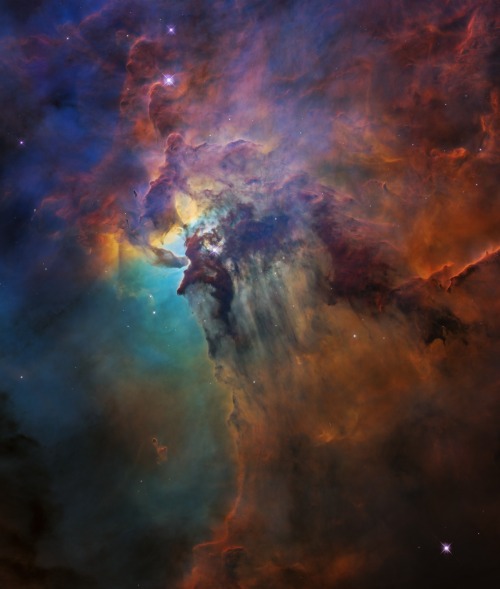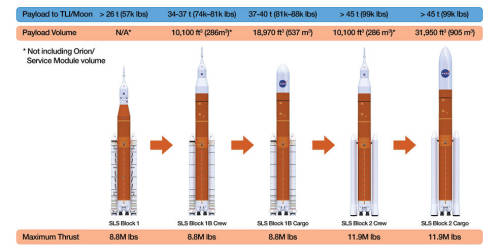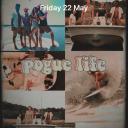The Lagoon Nebula

The Lagoon Nebula
This colorful image, taken by our Hubble Space Telescope between Feb. 12 and Feb. 18, 2018 , celebrated the Earth-orbiting observatory’s 28th anniversary of viewing the heavens, giving us a window seat to the universe’s extraordinary tapestry of stellar birth and destruction.
At the center of the photo, a monster young star 200,000 times brighter than our Sun is blasting powerful ultraviolet radiation and hurricane-like stellar winds, carving out a fantasy landscape of ridges, cavities, and mountains of gas and dust.
This region epitomizes a typical, raucous stellar nursery full of birth and destruction. The clouds may look majestic and peaceful, but they are in a constant state of flux from the star’s torrent of searing radiation and high-speed particles from stellar winds. As the monster star throws off its natal cocoon of material with its powerful energy, it is suppressing star formation around it.
Make sure to follow us on Tumblr for your regular dose of space: http://nasa.tumblr.com.
More Posts from Mousoudi20 and Others
5 Out-of-this-world Facts About Our Iconic Vehicle Assembly Building!

The Vehicle Assembly Building, or VAB, at our Kennedy Space Center in Florida, is the only facility where assembly of a rocket occurred that carried humans beyond low-Earth orbit and on to the Moon. For 30 years, its facilities and assets were used during the Space Shuttle Program and are now available to commercial partners as part of our agency’s plan in support of a multi-user spaceport. To celebrate the VAB’s continued contribution to humanity’s space exploration endeavors, we’ve put together five out-of-this-world facts for you!
1. It’s one of the largest buildings in the world by area, the VAB covers eight acres, is 525 feet tall and 518 feet wide.

Aerial view of the Vehicle Assembly Building with a mobile launch tower atop a crawler transporter approaching the building.
2. The VAB was constructed for the assembly of the Apollo/Saturn V Moon rocket, the largest rocket made by humans at the time.

An Apollo/Saturn V facilities Test Vehicle and Launch Umbilical Tower (LUT) atop a crawler-transporter move from the Vehicle Assembly Building (VAB) on the way to Pad A on May 25, 1966.
3. The building is home to the largest American flag, a 209-foot-tall, 110-foot-wide star spangled banner painted on the side of the VAB.

Workers painting the Flag on the Vehicle Assembly Building on January 2, 2007.
4. The tallest portions of the VAB are its 4 high bays. Each has a 456-foot-high door. The doors are the largest in the world and take about 45 minutes to open or close completely.

A mobile launcher, atop crawler-transporter 2, begins the move into High Bay 3 at the Vehicle Assembly Building (VAB) on Sept. 8, 2018.
5. After spending more than 50 years supporting our human spaceflight programs, the VAB received its first commercial tenant – Northrop Grumman Corporation – on August 16, 2019!

A model of Northrop Grumman’s OmegA launch vehicle is flanked by the U.S. flag and a flag bearing the OmegA logo during a ribbon-cutting ceremony Aug. 16 in High Bay 2 of the Vehicle Assembly Building.
Whether the rockets and spacecraft are going into Earth orbit or being sent into deep space, the VAB will have the infrastructure to prepare them for their missions.
Make sure to follow us on Tumblr for your regular dose of space: http://nasa.tumblr.com.
Be Glad You Don’t Have to Dust in Space!
Throw open the windows and break out the feather duster, because spring is here and it’s time to do a little cleaning! Fortunately, no one has to tidy up the dust in space — because there’s a lot of it — around 100 tons rain down on Earth alone every day! And there’s even more swirling around the solar system, our Milky Way galaxy, other galaxies and the spaces in between.

By studying the contents of the dust in your house — which can include skin cells, pet fur, furniture fibers, pollen, concrete particles and more — scientists learn a lot about your environment. In the same way, scientists can learn a lot by looking at space dust. Also called cosmic dust, a fleck of space dust is usually smaller than a grain of sand and is made of rock, ice, minerals or organic compounds. Scientists can study cosmic dust to learn about how it formed and how the universe recycles material.

“We are made of star-stuff,” Carl Sagan famously said. And it’s true! When a star dies, it sheds clouds of gas in strong stellar winds or in an explosion called a supernova. As the gas cools, minerals condense. Recent observations by our SOFIA mission suggest that in the wake of a supernova shockwave, dust may form more rapidly than scientists previously thought. These clouds of gas and dust created by the deaths of stars can sprawl across light-years and form new stars — like the Horsehead Nebula pictured above. Disks of dust and gas form around new stars and produce planets, moons, asteroids and comets. Here on Earth, some of that space dust eventually became included in living organisms — like us! Billions of years from now, our Sun will die too. The gas and dust it sheds will be recycled into new stars and planets and so on and so forth, in perpetuity!

Astronomers originally thought dust was a nuisance that got in the way of seeing the objects it surrounded. Dust scatters and absorbs light from stars and emits heat as infrared light. Once we started using infrared telescopes, we began to understand just how important dust is in the universe and how beautiful it can be. The picture of the Andromeda galaxy above was taken in the infrared by our Spitzer Space Telescope and reveals detailed spirals of dust that we can’t see in an optical image.

We also see plenty of dust right here in our solar system. Saturn’s rings are made of mostly ice particles and some dust, but scientists think that dust from meteorites may be darkening the rings over time. Jupiter also has faint dusty rings, although they’re hard to see — Voyager 1 only discovered them when it saw them backlit by the Sun. Astronomers think the rings formed when meteorite impacts on Jupiter’s moons released dust into orbit. The Juno spacecraft took the above picture in 2016 from inside the rings, looking out at the bright star Betelgeuse.

Copyright Josh Calcino, used with permission
And some space dust you can see from right here on Earth! In spring or autumn, right before sunrise or after sunset, you may be able to catch a glimpse of a hazy cone of light above the horizon created when the Sun’s rays are scattered by dust in the inner solar system. You can see an example in the image above, extending from above the tree on the horizon toward a spectacular view of the Milky Way. This phenomenon is called zodiacal light — and the dust that’s reflecting the sunlight probably comes from icy comets. Those comets were created by the same dusty disk that that formed our planets and eventually you and the dust under your couch!
Make sure to follow us on Tumblr for your regular dose of space: http://nasa.tumblr.com
I’m really intrigued about this shipping thing and who I would match haha...Can I have an Outer Banks ship? My icon is actually me! I’m a straight female, 5’5 with mid length brown hair and brown eyes. I love older music like 70s rock bands but also love pop/rock music for driving with the windows down like Taylor Swift or Avril Lavigne. I’m from South Carolina and I love Kayaking and Paddle Boarding I also like just reading a good book. The most important thing to me is a sense of adventure!
outer banks

i ship you with john b!
• you and john b go on adventures all the time. there isn’t a mountain or hiking trail you two haven’t gone on. you guys also sneak into a lot of abandoned places.
• he also would teach you how to surf. he’s not the best teacher, but you get the hang of it anyway.
• naps in the twinkie>
• him laying his head in your lap while you read
• i feel like he might listen to the same music you do
• screaming complicated by avril with the windows down and full volume
How might the next-step fusion machine look like? The European version resembles #ITER, but it's not the same. #DEMO will have electricity-generating installations like any power plant. Have a peek! https://t.co/kEk5BkTpeS #fusionenergy #WeAreITER https://t.co/hHGah1fGbQ
Five Record-Setting Gamma-ray Bursts!
For 10 years, our Fermi Gamma-ray Space Telescope has scanned the sky for gamma-ray bursts (GRBs), the universe’s most luminous explosions!

Most GRBs occur when some types of massive stars run out of fuel and collapse to create new black holes. Others happen when two neutron stars, superdense remnants of stellar explosions, merge. Both kinds of cataclysmic events create jets of particles that move near the speed of light.
A new catalog of the highest-energy blasts provides scientists with fresh insights into how they work. Below are five record-setting events from the catalog that have helped scientists learn more about GRBs:
1. Super-short burst in Boötes!

The short burst 081102B, which occurred in the constellation Boötes on Nov. 2, 2008, is the briefest LAT-detected GRB, lasting just one-tenth of a second!
2. Long-lived burst!

Long-lived burst 160623A, spotted on June 23, 2016, in the constellation Cygnus, kept shining for almost 10 hours at LAT energies — the longest burst in the catalog.
For both long and short bursts, the high-energy gamma-ray emission lasts longer than the low-energy emission and happens later.
3. Highest energy gamma-rays!

The highest-energy individual gamma ray detected by Fermi’s LAT reached 94 billion electron volts (GeV) and traveled 3.8 billion light-years from the constellation Leo. It was emitted by 130427A, which also holds the record for the most gamma rays — 17 — with energies above 10 GeV.
4. In a constellation far, far away!

The farthest known GRB occurred 12.2 billion light-years away in the constellation Carina. Called 080916C, researchers calculate the explosion contained the power of 9,000 supernovae.
5. Probing the physics of our cosmos!

The known distance to 090510 helped test Einstein’s theory that the fabric of space-time is smooth and continuous. Fermi detected both a high-energy and a low-energy gamma ray at nearly the same instant. Having traveled the same distance in the same amount of time, they showed that all light, no matter its energy, moves at the same speed through the vacuum of space.
Make sure to follow us on Tumblr for your regular dose of space: http://nasa.tumblr.com.

2019 August 14
Saturn Behind the Moon Image Credit: Peter Patonai (Astroscape Photography)
Explanation: What’s that next to the Moon? Saturn. In its monthly trip around the Earth – and hence Earth’s sky – our Moon passed nearly in front of Sun-orbiting Saturn earlier this week. Actually the Moon passed directly in front of Saturn from the viewpoints of a wide swath of Earth’s Southern Hemisphere. The featured image from Sydney, Australia captured the pair a few minutes before the eclipse. The image was a single shot lasting only 1/500th of a second, later processed to better highlight both the Moon and Saturn. Since Saturn is nearly opposite the Sun, it can be seen nearly the entire night, starting at sunset, toward the south and east. The gibbous Moon was also nearly opposite the Sun, and so also visible nearly the entire night – it will be full tomorrow night. The Moon will occult Saturn again during every lap it makes around the Earth this year.
∞ Source: apod.nasa.gov/apod/ap190814.html
Another #LEGO model! ENGAGE, Europe's architect/engineer contractor for #ITER construction, presents a colourful LEGO model of the #Tokamak Building at their #IBF19 exhibition stand. #WeAreITER @fusionforenergy https://t.co/4w7rTpsLSU

The trickster “Blinking Planetary”
Planetary nebula NGC 6826 is located about 4,200 light years from Earth in Cygnus. When observers look directly at it through a small telescope, they typically see only the nebula’s sparkling-white central star. However, by averting one’s gaze, glancing away from the central star, the nebula’s bulbous dust clouds come into view. This optical trickery earned this planetary nebula the name the “Blinking Planetary.”
Over the next several thousand years, the nebula will gradually disperse into space, and then the central star will slowly cool as it radiates its energy for billions of years as a white dwarf.
Make sure to follow us on Tumblr for your regular dose of space: http://nasa.tumblr.com
The Perseid Meteor Shower Is Here!

Image Credit: NASA/Bill Ingalls
The Perseids are at their peak this week!
The Perseid meteor shower, one of the biggest meteor showers of the year, will be at its brightest early in the morning on Wednesday, August 12. Read on for some tips on how to watch the night sky this week – and to find out: what exactly are the Perseids, anyway?

Credit: NASA/Bill Ingalls
Your best chance to spot the Perseids will be between 2 AM and dawn (local time) the morning of August 12. Find a dark spot, avoid bright lights (yes, that includes your phone) and get acclimated to the night sky.
Your eyes should be at peak viewing capacity after about 30 minutes; though the Moon may block out some of the dimmer meteors, you should still be able to see up to 15-20 an hour. If you’re not an early bird, you can try and take a look soon after sunset (around 9 PM) on the 11th, though you may not see as many Perseids then.

Credit: NASA/MEO
If it’s too cloudy, or too bright, to go skywatching where you are, you can try again Wednesday or Thursday night – or just stay indoors and watch the Perseids online!
Our Meteor Watch program will be livestreaming the Perseids from Huntsville, Alabama on Facebook (weather permitting), starting around 9 p.m. EDT on August 11 and continuing through sunrise.
So… why are they called the Perseids?
Because all of a meteor shower’s meteors have similar orbits, they appear to come from the same place in the sky – a point called the radiant.

The radiant for the Perseids, as you might guess from the name, is in the constellation Perseus, found near Aries and Taurus in the night sky.
But they’re not actually coming from Perseus, right?

Credit: NASA/Joel Kowsky
Right! The Perseids are actually fragments of the comet Swift-Tuttle, which orbits within our solar system.
If you want to learn more about the Perseids, visit our Watch the Skies blog or check out our monthly “What’s Up” video series. Happy viewing!
Make sure to follow us on Tumblr for your regular dose of space: http://nasa.tumblr.com
We Like Big Rockets and We Cannot Lie: Saturn V vs. SLS
On this day 50 years ago, human beings embarked on a journey to set foot on another world for the very first time.

At 9:32 a.m. EDT, millions watched as Apollo astronauts Neil Armstrong, Buzz Aldrin and Michael Collins lifted off from Launch Pad 39A at the Kennedy Space Center in Cape Canaveral, Florida, flying high on the most powerful rocket ever built: the mighty Saturn V.

As we prepare to return humans to the lunar surface with our Artemis program, we’re planning to make history again with a similarly unprecedented rocket, the Space Launch System (SLS). The SLS will be our first exploration-class vehicle since the Saturn V took American astronauts to the Moon a decade ago. With its superior lift capability, the SLS will expand our reach into the solar system, allowing astronauts aboard our Orion spacecraft to explore multiple, deep-space destinations including near-Earth asteroids, the Moon and ultimately Mars.

So, how does the Saturn V measure up half a century later? Let’s take a look.
Mission Profiles: From Apollo to Artemis
Saturn V

Every human who has ever stepped foot on the Moon made it there on a Saturn V rocket. The Saturn rockets were the driving force behind our Apollo program that was designed to land humans on the Moon and return them safely back to Earth.

Developed at our Marshall Space Flight Center in the 1960s, the Saturn V rocket (V for the Roman numeral “5”) launched for the first time uncrewed during the Apollo 4 mission on November 9, 1967. One year later, it lifted off for its first crewed mission during Apollo 8. On this mission, astronauts orbited the Moon but did not land. Then, on July 16, 1969, the Apollo 11 mission was the first Saturn V flight to land astronauts on the Moon. In total, this powerful rocket completed 13 successful missions, landing humans on the lunar surface six times before lifting off for the last time in 1973.
Space Launch System (SLS)

Just as the Saturn V was the rocket of the Apollo generation, the Space Launch System will be the driving force behind a new era of spaceflight: the Artemis generation.

During our Artemis missions, SLS will take humanity farther than ever before. It is the vehicle that will return our astronauts to the Moon by 2024, transporting the first woman and the next man to a destination never before explored – the lunar South Pole. Over time, the rocket will evolve into increasingly more powerful configurations to provide the foundation for human exploration beyond Earth’s orbit to deep space destinations, including Mars.
SLS will take flight for the first time during Artemis 1 where it will travel 280,000 miles from Earth – farther into deep space than any spacecraft built for humans has ever ventured.
Size: From Big to BIGGER
Saturn V

The Saturn V was big.
In fact, the Vehicle Assembly Building at Kennedy Space Center is one of the largest buildings in the world by volume and was built specifically for assembling the massive rocket. At a height of 363 feet, the Saturn V rocket was about the size of a 36-story building and 60 feet taller than the Statue of Liberty!
Space Launch System (SLS)

Measured at just 41 feet shy of the Saturn V, the initial SLS rocket will stand at a height of 322 feet. Because this rocket will evolve into heavier lift capacities to facilitate crew and cargo missions beyond Earth’s orbit, its size will evolve as well. When the SLS reaches its maximum lift capability, it will stand at a height of 384 feet, making it the tallest rocket in the world.
Power: Turning Up the Heat
Saturn V
For the 1960s, the Saturn V rocket was a beast – to say the least.
Fully fueled for liftoff, the Saturn V weighed 6.2 million pounds and generated 7.6 million pounds of thrust at launch. That is more power than 85 Hoover Dams! This thrust came from five F-1 engines that made up the rocket’s first stage. With this lift capability, the Saturn V had the ability to send 130 tons (about 10 school buses) into low-Earth orbit and about 50 tons (about 4 school buses) to the Moon.
Space Launch System (SLS)

Photo of SLS rocket booster test
Unlike the Saturn V, our SLS rocket will evolve over time into increasingly more powerful versions of itself to accommodate missions to the Moon and then beyond to Mars.

The first SLS vehicle, called Block 1, will weigh 5.75 million pounds and produce 8.8 million pounds of thrust at time of launch. That’s 15 percent more than the Saturn V produced during liftoff! It will also send more than 26 tons beyond the Moon. Powered by a pair of five-segment boosters and four RS-25 engines, the rocket will reach the period of greatest atmospheric force within 90 seconds!

Following Block 1, the SLS will evolve five more times to reach its final stage, Block 2 Cargo. At this stage, the rocket will provide 11.9 million pounds of thrust and will be the workhorse vehicle for sending cargo to the Moon, Mars and other deep space destinations. SLS Block 2 will be designed to lift more than 45 tons to deep space. With its unprecedented power and capabilities, SLS is the only rocket that can send our Orion spacecraft, astronauts and large cargo to the Moon on a single mission.
Build: How the Rockets Stack Up
Saturn V

The Saturn V was designed as a multi-stage system rocket, with three core stages. When one system ran out of fuel, it separated from the spacecraft and the next stage took over. The first stage, which was the most powerful, lifted the rocket off of Earth’s surface to an altitude of 68 kilometers (42 miles). This took only 2 minutes and 47 seconds! The first stage separated, allowing the second stage to fire and carry the rest of the stack almost into orbit. The third stage placed the Apollo spacecraft and service module into Earth orbit and pushed it toward the Moon. After the first two stages separated, they fell into the ocean for recovery. The third stage either stayed in space or crashed into the Moon.
Space Launch System (SLS)
Much like the Saturn V, our Space Launch System is also a multi-stage rocket. Its three stages (the solid rocket boosters, core stage and upper stage) will each take turns thrusting the spacecraft on its trajectory and separating after each individual stage has exhausted its fuel. In later, more powerful versions of the SLS, the third stage will carry both the Orion crew module and a deep space habitat module.
A New Era of Space Exploration
Just as the Saturn V and Apollo era signified a new age of exploration and technological advancements, the Space Launch System and Artemis missions will bring the United States into a new age of space travel and scientific discovery.
Join us in celebrating the 50th anniversary of the Apollo 11 Moon landing and hear about our future plans to go forward to the Moon and on to Mars by tuning in to a special two-hour live NASA Television broadcast at 1 p.m. ET on Friday, July 19. Watch the program at www.nasa.gov/live.
Make sure to follow us on Tumblr for your regular dose of space: http://nasa.tumblr.com.
-
 dotglobal liked this · 5 months ago
dotglobal liked this · 5 months ago -
 emibertachini liked this · 1 year ago
emibertachini liked this · 1 year ago -
 linkdovetentra liked this · 1 year ago
linkdovetentra liked this · 1 year ago -
 eexitmusicforafilm liked this · 1 year ago
eexitmusicforafilm liked this · 1 year ago -
 ravexandxlust liked this · 1 year ago
ravexandxlust liked this · 1 year ago -
 svorenanobog liked this · 1 year ago
svorenanobog liked this · 1 year ago -
 angelsfat liked this · 2 years ago
angelsfat liked this · 2 years ago -
 veggiesforthelionking liked this · 2 years ago
veggiesforthelionking liked this · 2 years ago -
 indigobluespryte reblogged this · 2 years ago
indigobluespryte reblogged this · 2 years ago -
 mellowmakermugpalace liked this · 2 years ago
mellowmakermugpalace liked this · 2 years ago -
 jewevan liked this · 2 years ago
jewevan liked this · 2 years ago -
 suncloudess reblogged this · 2 years ago
suncloudess reblogged this · 2 years ago -
 alexis-vega-h reblogged this · 2 years ago
alexis-vega-h reblogged this · 2 years ago -
 isla-vic liked this · 3 years ago
isla-vic liked this · 3 years ago -
 kuixotic reblogged this · 3 years ago
kuixotic reblogged this · 3 years ago -
 kuixotic liked this · 3 years ago
kuixotic liked this · 3 years ago
